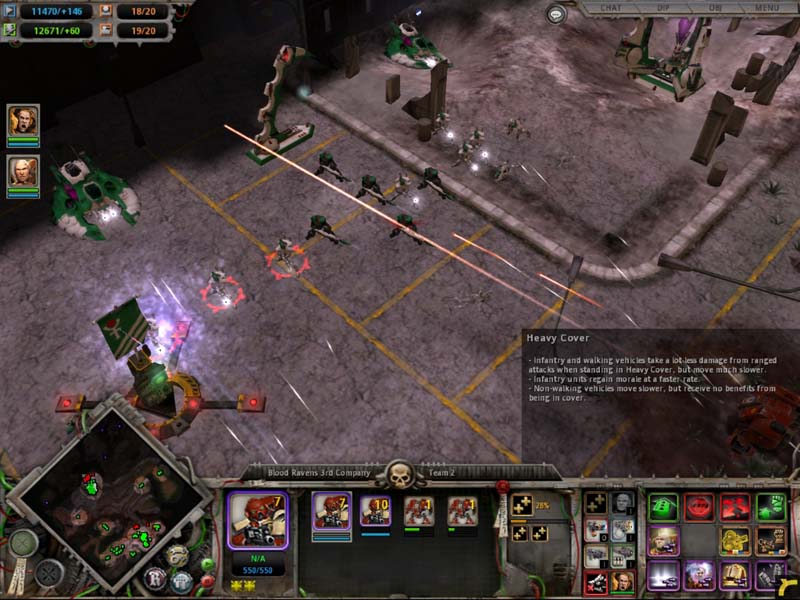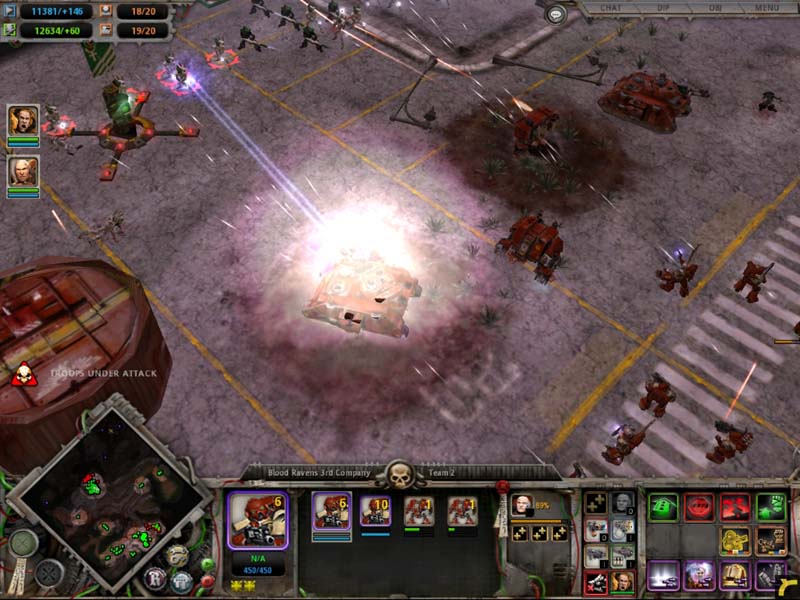

Warhammer 40k: Dawn of War Review
Name: Warhammer 40k: Dawn of War
Genre: Real Time Strategy
From: Relic Entertainment
A brief word of explanation first, why is this review coming out now? Simply, I was working on this review on or about October 28th when I received an urgent call from my wife telling me to get to the OB's office right away. En route, I received a call to go directly to the hospital where my son was born less than an hour later. With his time in the Neonatal Intensive Care Unit, I didn't do much at all on the site. I was just trying to keep my head above water. Then he came home and most extraneous activities stopped. Now we're finally in a routine and I'm catching up on stuff left on the back burner. Congratulations Dawn of War (DoW) it's your turn.
If you recall the Real Time Continuum, I had listed DoW well toward the combat end. That's not an exaggeration. While you do have structures, most of the gameplay focuses on combat, bloody, visceral combat at that. It certainly deserves its "M" rating from the ESRB. Literally fountains of blood will flow in the course of your combat campaign. It's not tasteless and is done in a somewhat cartoony manner. The whole game exudes a joyful attitude during its dance of destruction. If that's not something you can get into, stay away.
Some people have complained that the RTS genre has grown to stale and detached. DoW address these concerns head on. Infantry units are in squads. Even with the large squads of Orks, you're not going to sending endless waves of attackers at the enemy. The game is designed to keep you up close and personal for the action. Your squads have value and the game encourages you to keep them alive. In fact the rarest resource in the game is time. It takes a while to get squads and units fully upgraded and configured the way you want.
The importance of time keeps the game constantly moving. You must press your advantage when winning or you'll be where you were (or weaker) than when you started the battle. In fact the Chaos mega unit, the Bloodthirster demon, demonstrates this perfectly. It actually takes damage any time it's not in combat. It's there to lead the howling hordes of Chaos in crushing their enemies not to guard the pass.
Let's get to the run down.
Graphics

There's no denying DoW is a beautiful game unless you don't like the sight of virtual blood. The game has a distinct art style that builds on it board game roots. Units are well animated. Since the game encourages you to zoom in and focus on important battles, you really get to appreciate the eye candy. I can't think of a RTS game that looks better. On the practical side, units are easy to pick out. Since you design your own color scheme, you can customize your multiplayer squad to look just the way you want them to.
There's plenty of special effects going on as well. Particles, smoke and explosions fill the screen. Special weapons have their own colors and effects. The flames from a flamer are quite impressive (when not being used against you). The different factions are equally easy to tell apart. The animators have gone overboard, so no two battles ever look identical. The special animations impress with both the artistic flair and the blood gibs.
Sound
Over all, the sound in DoW is quite good. Unit sounds match their animation and appearance. There's some up and down voice acting in the single player campaign, but the bulk of the game sounds good enough and immersive enough that you never notice it hitting a wrong key.
Gameplay

The mechanics of the game are interesting. Similar to Ground Control 2, there are control points you have to capture and hold to build resources. This encourages rapid expansion and creates natural conflict points. Relic also made the decision to make defensive structures relatively weak. They can slow down an enemy or hold off a small skirmishing unit, but if they don't get backup, they'll quickly be destroyed. At every turn the game's design encourages you to throw your units into combat.
Once there, you have plenty of micro options among your units. Combined forces will usually decimate single unit types, but there is enough flexibility in the unit upgrades that you can create different forces from the same base unit. For instance, the Space Marine infantry equipped with flamers or bolters is more effective against infantry. While the same infantry equipped with missile launchers or plasma guns is better against armor.
At its heart, DoW is a traditional RTS with a heavy emphasis on combat. You build your base with peons. New structures move you up the tech tree. Resources come from the control points, as mentioned, and from structures you build (improved control point towers, energy generators, and, for Orks, Waaugh banners). You have hero units that improve the performance of squads they are attached to. Heroes are especially important against opposing mega units and keep to keep up morale.
I like the move to add fun morale to combat games. In DoW, certain weapons such as flamers and artillery do extra damage to a unit's morale. When morale breaks, the unit loses most of its combat effectiveness. Morale will return over time or can be boosted using special abilities. With this type of morale you're encouraged to get your broken units out of the fray, but you also have the option to move other units between them and the enemy so they can recover without quitting the field. Let's just say it's a lot more fun moving your units around to maximize combat effectiveness than it is to chase down units running away at random and hoping they'll be there when you need them.
The biggest problem with this game is if you're the type of player who only plays the campaign and are not interested in skirmish or multiplayer. The campaign only exposes you to one side, the Space Marines. You fight all the other factions, but only play one. The story is good, but short and predictable. Some of the more scripted missions also don't seem capture the fun of the game design. Overall the campaign is not a good showcase for the game. If that's all you're interested in, knock a point or two off the final score.
Multiplayer and Skirmish
The combat AI in skirmish is really pretty good as you crank up the difficulty. If you're into single player skirmish, you'll have a blast with this game. There are good options, the sides play differently. Most of the maps are well designed and open enough to encourage the combat oriented gameplay DoW has to offer.
Online multiplayer has a good functional lobby system. Connections were quick and easy. I didn't have any significant difficulty with lag or lost connections. That's good considering the overall fast pace of the game.
Normally I describe the factions in gameplay, but since you only play one side in the single player campaign, I'll put them here.
The Orks are the most physical of the factions. They use large numbers to overwhelm their enemies. If you aren't interested in micromanagement, the Orks are for you. There's little subtly here. The more Orks you have, the stronger you are. The Orks attack in waves. They need to recover if their morale gives out because broken they will be slaughtered quickly. Their muscle bound green skin isn't the only resemblance to the Hulk. Orks Smash.
If you don't mind a little micro, the Space Marines are next. They are balanced and have great customization options. You won't lead hordes of Space Marines, but you will wield a powerful destructive force with them. They're easy to get into if you've played any RTS before. They also have a familiar sci fi feel to them. That's probably why they're the focus of the single player campaign.
The sworn enemies of the Space Marines are the Chaos Space Marines. They have even more specialized units and require more micromanagement. They still well balanced like their good counterparts, but their main strength comes from the magic they wield and the Daemons that fight with them. Chaos Marine units all sport a decayed, evil look to them.
Finally we have the Eldar. They are few in numbers, but they have great technology and magical powers to level the playing field. They require micromanagement and misdirection to play well. They move fast, but require combined arms to fight effectively. The units are highly specialized and will not do well outside their area of expertise. Their high mobility (and teleport ability) means that no area is safe behind the front lines.
As you can see the factions each play quite differently. That makes multifaction battles quite interesting. The constant expansion and combat leaves almost no dead time. While you can't ignore the tech tree, you can't race up it to victory either. You have to get the feel for the ebb and flow of your chosen faction and then use good combat tactics to win.
Conclusion
With the possible exception of the short single play campaign, DoW excels at everything it sets out to do. It provides a solid RTS game. Improves on earlier games with fun morale and constant combat with a diminished emphasis on resources and structures. You feel more like a general fighting a battle than a training barracks commander pumping out the fodder.
On the negative side, there's the short campaign, up and down voice work, and the game's just too bloody and violent for some people.
Overall Score = 9.0
I know, some of you are saying, Jason, that's more than you gave Ground Control 2, so it must be a better game. Not necessarily. They both do an excellent job at what they set out to do. In many ways, Ground Control 2 is a better game, but DoW will appeal to more people with its four factions, varied gameplay and sense of fun. That's why it nudges ahead.